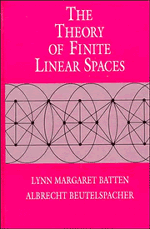Book contents
- Frontmatter
- Contents
- In memory of PAUL de WITTE 1931–1980
- Preface
- 1 The essentials
- 2 Complementation
- 3 Line sizes
- 4 Semiaffine linear spaces
- 5 Semiaffine linear spaces with large order
- 6 Linear spaces with few lines
- 7 d-Dimensional linear spaces
- 8 Group action on linear spaces
- Appendix
- Notation index
- Subject index
7 - d-Dimensional linear spaces
Published online by Cambridge University Press: 05 May 2010
- Frontmatter
- Contents
- In memory of PAUL de WITTE 1931–1980
- Preface
- 1 The essentials
- 2 Complementation
- 3 Line sizes
- 4 Semiaffine linear spaces
- 5 Semiaffine linear spaces with large order
- 6 Linear spaces with few lines
- 7 d-Dimensional linear spaces
- 8 Group action on linear spaces
- Appendix
- Notation index
- Subject index
Summary
The definition
Given an arbitrary linear space S = (p, ℒ), there is a natural way of introducing further structure on S by distinguishing subsets of p with the property that any element of ℒ containing at least two points of such a subset must be wholly contained within the subset. We call any subset of p with the above property, along with the induced lines, a subspace of 5. Clearly φ and S themselves are subspaces. Moreover, the intersection of any set of subspaces is again a subspace (the empty intersection being S), and so a closure space is induced on S, the closure of any set X of points of p being the intersection of all subspaces containing X.
There are various ways in which a ‘dimension’ can now be assigned to subspaces. In any case, we normally wish to assign dimensions 0 and 1 to the points and lines respectively, and require that V ⊂ W implies that the dimension of V be less than or equal to the dimension of W. We shall make the following definition.
- Type
- Chapter
- Information
- The Theory of Finite Linear SpacesCombinatorics of Points and Lines, pp. 136 - 166Publisher: Cambridge University PressPrint publication year: 1993

